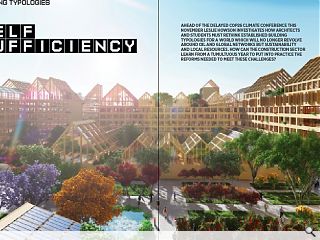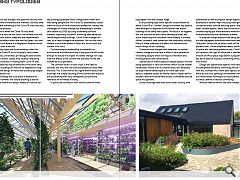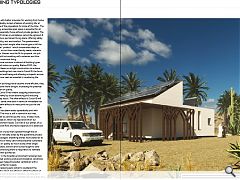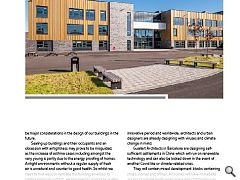Self Sufficiency: Building Typologies
18 Jan 2021
Ahead of the delayed COP26 climate conference this November Leslie Howson investigates how architects and students must rethink established building typologies for a world which will no longer revolve around oil and global networks but sustainability and local resources. How can the construction sector learn from a tumultuous year to put into practice the reforms needed to meet these challenges?
The climate crisis has brought into question not only how we build, in terms of materials and methods, but also what we build and the immediacy of the Covid-19 crisis has only accelerated that process.
Irrespective of when the Covid-19 crisis ends (hopefully with a vaccine and soon), the climate crisis will remain and unless drastic measures are implemented quickly and take effect within the next ten years, our lives and our planet will remain in a dangerous situation which requires more than a vaccine.
Most building types are found wanting under the pressure of the Covid-19 virus. Hospitals, care homes, offices, factories, universities, private gyms and schools have all had to remain closed, only recently reopening thanks to inventiveness in making them Covid-19 safe. Whilst such measures may be effective in the short term, many existing buildings will have to be adapted for long term use and the design of many new building typologies are now in question too.
Ensuring buildings are virus-proof is essential to public health. However, this future-proofing is also an opportunity to review the design validity of some of our key building typologies from a longer-term health and well-being perspective. Pre Covid-19, sustainability issues were the focus of the architectural profession, notably the challenges of climate change and attempting to achieve zero carbon by 2050 by using sustainably sourced material, improving insulation, achieving zero waste and retrofitting existing buildings.
Covid-19 has changed all that, or at least changed the emphasis, for not only must climate crisis issues remain in focus but so too must the current virus crisis. Concentrating on embedding sustainability in architectural education and day to day practice will not be enough to reduce the impact of climate change nor cope with the effects of the current and possibly not the last worldwide virus pandemic. The common factor in both crises is the need to consider not only how we build sustainably but also what we build.
This is the time for an urgent rethink about new buildings, not simply focusing on the construction aspects but questioning their very conception, purpose and relevance to the needs of today. In particular, architects must rethink some of these typologies from the concept stage. Every building type raises specific issues relative to either Covid-19 or Climate Change but several key aspects have emerged in response to the former that allows buildings to be safely reoccupied. The focus is on hygiene and the provision of extra hand washing facilities and social distancing and circulation most notably in schools, offices, hospitals, care homes and the hospitality industry. Many of these measures will affect the imminent and future design of our buildings.
Combine these changes with measures to combat climate change and we have in effect a new generation of building designs which will require innovation and thinking beyond the conventional. Operational as well as physical design aspects are now being addressed in new care homes which include smaller households, rooms with en suite facilities, less emphasis on large internal shared space, no more open-plan layouts, separate access for family visitors, higher staff to resident ratios and convenient access to sheltered outside space and gardens. School buildings have also come under scrutiny with operational as well as physical design aspects now being addressed in several ways including more generous circulation areas, outside teaching space, larger floor areas, flexible spaces, doors that minimise touching, children staying put while teachers move about and multiple entrances and ventilation systems. In hospitals design aspects now being addressed include segregated admission areas and clean zones (the public should not be able to walk off the street to a patients bed), virtual outpatient areas, better purposing of space and rethinking intensive care.
Covid19 has thrown into question the type of office that is needed and the amount of office space required for a population which has had a taste of reduced commuting life by working from home. Design and operational aspects now being considered include greater flexibility, rethinking vertical circulation with less crowded lifts, fewer desk spaces, less staff in the office at one time, splitting time between home working and office-based working and the possibility of more local business centres to reduce commuting. We also need to rethink the very concept and form of new housing, with better provision for working from home which will probably remain a feature of working life, at least for some of the population for some of the time. The need for easily accessible open space is essential for all households, especially those without private gardens. The possibilities of homes as workplaces cannot be ignored. A home should be a permanent living place, offering safety, security, stability, rest and comfort.
The predominant and supposedly most sought after house type is still the neo-traditional `product` which households adapt as best they can to suit their varied family needs, interests and schedules. Houses must be fit for purpose, not just sustainably built but enabling self-contained and thus more climate-conscious living. One key issue common to almost all building types is the matter of indoor air quality. Before 2020, the emphasis had been on airtight construction to achieve carbon zero buildings but now due to Covid-19, the focus is on health and well being and allowing occupants access to fresh air is now seen as essential in countering the virus. As modern buildings have become more efficient, they have also become more airtight, increasing the potential for poor indoor air quality. Fighting Covid-19 has meant stopping transmission of a deadly enemy by social distancing and reducing transmission by touch. The after-effects of Covid-19 will be with us for some time both in terms of immediate risk and the long term effects on many and not just the old and vulnerable. Lockdown has been eased sporadically and with mixed effect. The virus is still in control of our lives, however, whilst we cannot see the virus, it hates most, fresh unpolluted air, which we need and which our planet’s environment needs. Survival of our planet, of us as humans and all flora and fauna depends on a balanced ecosystem.
The virus on cruise liners spread through the air supply system ironically aided by the quarantine process itself with passengers breathing shared recirculated air at night. Residents in many care homes became vulnerable through poor air quality as much as any other single factor. In hospitals, doctors and nurses fought to save patients by connecting them to respirators to ventilate their airways with purified air. Yet the air in the hospital environment remained less pure. Congested working and accommodation conditions would have been helped by better ventilation with a cleaner and purified air supply.
As well as reducing zero carbon to counteract the heating up of the planet and efforts to offset the effects of climate change such as flood remediation, we have learnt from the Covid-19 situation that ventilation and air quality will be major considerations in the design of our buildings in the future. Sealing up buildings and their occupants and an obsession with airtightness may prove to be misguided, as the increase of asthma cases including amongst the very young is partly due to the energy proofing of homes. Airtight environments without a regular supply of fresh air is unnatural and counter to good health. So whilst we need to find ways to ventilate the building envelope to control moisture content, we also need to control air quality including moisture levels for the occupants. The fallout and lessons learned from Covid-19 share common factors with climate change issues and remediation measures. So this is a `double wake up call` providing both opportunities and challenges.
These are unprecedented and extremely challenging times requiring innovative thinking about how we should be live and what kind of built environment best deals with climate change issues while protecting society against sudden threats from Covid type viruses. Architects should be at the forefront in such an innovative period and worldwide, architects and urban designers are already designing with viruses and climate change in mind. Guallart Architects in Barcelona are designing self-sufficient settlements in China which will run on renewable technology and can also be locked down in the event of another Covid like or climate-related crisis.
They will contain mixed development blocks containing shops, homes and offices. All homes will have immediate access to outside landscaped space and community-run food production. Perhaps now what is required in Scotland, is a `think tank` approach with eager but unemployed young architects at the heart of a process of reviewing current building typologies together with specialist architects, to produce innovative design alternatives. With COP26 only a year away why not host a series of international video conferences in Scotland, to be attended by architects in each field to discuss the re-envisioning of some of these key building types in light of the lessons learned from both Covid-19 and climate change.
|
|






